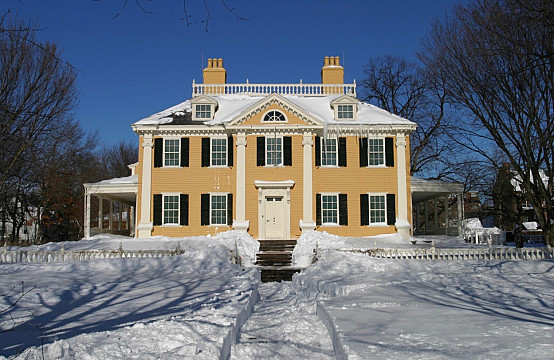Longfellow House
105 Brattle Street, Cambridge, Massachusetts
Built in 1759, for John Vassall (1738-1797) and his wife, Elizabeth Oliver (1744-1807). Mrs Vassall was the sister of Thomas Oliver, the last Royal Lieutenant-Governor of Massachusetts, and being Loyalists, on the outbreak of Revolution they left Cambridge and their property (this house and its accompanying 150-acres) was confiscated. In July, 1775, George Washington requisitioned the house as his headquarters and lived here throughout the Siege of Boston until April, 1776. It was confiscated from the Vassalls in 1779 and was sold two years later (1781) to the millionaire privateer Nathaniel Tracy. He "lived here in great lavishness" and expanded the property to 140-acres before he met with financial ruin in 1786 and sold up to another "merchant prince," Thomas Russell, the first President of the National Bank in Boston....

This house is best associated with...
In 1791, Russell sold what had been his summer house to the former Apothecary-General to the Continental Army, Andrew Craigie, and it soon became known as the "Craigie Mansion". He and his wife gained a reputation as people who, "entertained without regard to expense... kept dozens of servants and well stocked stables and wine cellars". Among the many notable guests who dined and danced here during their tenure was Queen Victoria's father, the Duke of Kent & Strathearn. But, after Craigie died, their extravagant lifestyle caught up with his increasingly eccentric widow, Betsy, who after selling much of their art and furniture to cover debts ended her days here taking in boarders.
In 1837, one of the boarders taken in by Betsy was Harvard's newly appointed Professor of Modern Languages, Henry Wadsworth Longfellow. She died in 1841 and two years later Nathaniel Appleton bought the house for $10,000 as a wedding present for his daughter, Fanny, who that same year was married to the very same Henry Wadsworth Longfellow.
Fanny died in 1861 and Longfellow remained here until his death too, in 1882. Their philanthropic daughter, Alice, was born here and after her father's death she lived here until her own in 1928. In 1913, she and her siblings created the Longfellow House Trust which maintained the home and allowed future Longfellows to live here if they so wished. In 1972, the trustees transferred ownership to the National Park Service allowing it to become a National Historic Site. The house is almost entirely unchanged from the time when it was home to the great poet and since 1972 it has been open to the public.
In 1837, one of the boarders taken in by Betsy was Harvard's newly appointed Professor of Modern Languages, Henry Wadsworth Longfellow. She died in 1841 and two years later Nathaniel Appleton bought the house for $10,000 as a wedding present for his daughter, Fanny, who that same year was married to the very same Henry Wadsworth Longfellow.
Fanny died in 1861 and Longfellow remained here until his death too, in 1882. Their philanthropic daughter, Alice, was born here and after her father's death she lived here until her own in 1928. In 1913, she and her siblings created the Longfellow House Trust which maintained the home and allowed future Longfellows to live here if they so wished. In 1972, the trustees transferred ownership to the National Park Service allowing it to become a National Historic Site. The house is almost entirely unchanged from the time when it was home to the great poet and since 1972 it has been open to the public.
You May Also Like...
Categories
Styles
Share
Connections
Be the first to connect to this house. Connect to record your link to this house. or just to show you love it! Connect to Longfellow House →
















